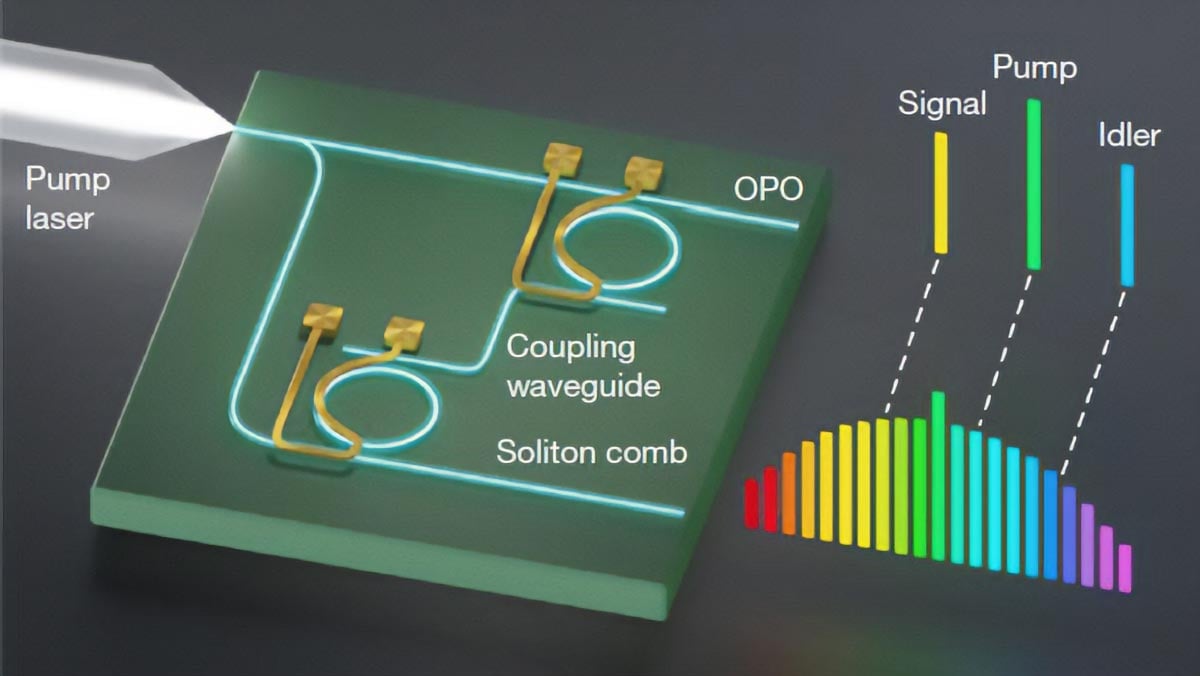
# Compact, All-Optical Device Produces Ultra-Low-Noise Microwave Signals
In a groundbreaking new study published in Nature, researchers at Columbia Engineering have developed a compact photonic chip that can generate high-quality, ultra-low-noise microwave signals using just a single laser. This innovative device, which is small enough to fit on the tip of a pencil, boasts the lowest microwave noise ever recorded in an integrated photonics platform. The implications of this achievement are far-reaching, with potential applications in high-speed communication, atomic clocks, and autonomous vehicles.
## The Challenge of Noise in Microwave Generation
Microwave sources are essential components of electronic devices used in global navigation, wireless communications, radar systems, and precision timing. To enhance the performance of these devices, reducing noise — random fluctuations in phase — on the microwave signal is crucial. Traditional methods of generating microwave signals have limitations when it comes to minimizing noise, prompting researchers to explore new techniques such as optical frequency division.
## Optical Frequency Division: A Game-Changer in Microwave Generation
Optical frequency division is a cutting-edge method of converting high-frequency signals into lower frequencies with significantly reduced noise levels. While this technique has shown promise in producing low-noise microwave signals, existing systems require multiple lasers and a large physical footprint to house all the necessary components. The research team at Columbia Engineering set out to develop a more compact and efficient solution for optical frequency division.
## Quantum and Nonlinear Photonics: Pioneering Innovation
Led by Professor Alexander Gaeta, the Gaeta Lab at Columbia Engineering specializes in quantum and nonlinear photonics, focusing on the interaction of laser light with matter. Their expertise in nonlinear nanophotonics, frequency-comb generation, and quantum state manipulation paved the way for the creation of a groundbreaking on-chip device capable of generating ultra-low-noise microwave signals.
## The All-Optical Frequency Division Chip
The photonic chip developed by the Gaeta Lab features two microresonators made of silicon nitride that are optically coupled. A single-frequency laser drives both microresonators, with one serving as an optical parametric oscillator to produce two output waves at different frequencies. By leveraging the quantum correlations of the oscillator, the device achieves a significant reduction in microwave noise, surpassing previous noise suppression levels in integrated photonics platforms.
## Potential Impact and Future Applications
The compact, all-optical device for optical frequency division opens up a plethora of possibilities in telecommunications, precision measurement, and radar technology. With the ability to generate stable, low-noise microwave signals in a small, portable package, this innovation could revolutionize the design of future communication devices and enhance the performance of microwave radars used in autonomous vehicles.
## Collaborative Efforts and Future Directions
The success of this research project was made possible through close collaboration between the Gaeta Lab and Professor Michal Lipson’s group at Columbia Engineering. The fabrication of the photonic chip was a joint effort between researchers at Columbia and Cornell University, showcasing the power of interdisciplinary teamwork in driving innovation in photonics.
## FAQs
### What is optical frequency division?
Optical frequency division is a technique that involves converting a high-frequency signal into a lower frequency using optical components. This method allows for the generation of low-noise microwave signals with improved stability and precision.
### How does the all-optical frequency division chip work?
The photonic chip developed by the Gaeta Lab utilizes two microresonators to generate high-quality microwave signals with minimal noise. By leveraging the quantum correlations of an optical parametric oscillator, the device achieves unprecedented levels of noise suppression in an integrated platform.
### What are the potential applications of this technology?
The compact, all-optical device for optical frequency division has the potential to revolutionize telecommunications, precision timing, and radar systems. Its small footprint and low-noise characteristics make it ideal for applications requiring precise and stable microwave signals, such as high-speed communication and autonomous vehicles.
In conclusion, the groundbreaking work by the researchers at Columbia Engineering represents a significant leap forward in the field of integrated photonics. By developing a compact, all-optical device capable of producing ultra-low-noise microwave signals, the team has paved the way for a new era of miniaturized, high-performance electronic devices. This innovation holds immense promise for a wide range of applications, from telecommunications to autonomous vehicles, and is a testament to the power of interdisciplinary collaboration in driving technological advancement.


















